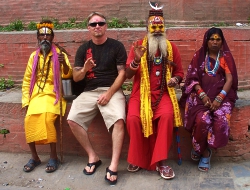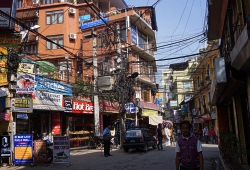The Chaotic Contrasts of Kathmandu
KATHMANDU is a sprawling nightmare. A million people live within the city’s labyrinth streets. Buddhist and Hindu temples are peppered throughout the city, their crumbling ramparts propped up with timber and hastily constructed retaining walls. Ancient buildings lean threateningly to one side; the adjacent buildings are sometimes the only obstacle delaying their catastrophic collapse. Incredibly, people still live in these dilapidated structures. Some inhabitants squat, cooking their meager meals over open ames. Others wash themselves with buckets of water on crumbling second-storey balconies, unconcerned with the potential avalanche surrounding them.
Kathmandu’s temples are concentrated into areas known as Durbar Squares, a generic name for a collection of temples, statues and open courts adjacent to ancient palaces. The most prominent temple in Kathmandu is Swayambhunath, known as the Monkey Temple. Located to the west of Kathmandu Durbar Square, the temple has a solitary cone that rises high above the throng of buildings. Hoards of chattering anarchistic monkeys roam the temple. Confident and bold on their own turf, they press visiting humans for handouts and look for a chance to relieve unwary tourists of their refreshments or unguarded articles. Occasionally, local policemen shoot strategically propelled stones with slingshots at the rowdy monkeys to disperse them when they become too emboldened. At its crest sits a Buddhist temple, accompanied by a stupa – a dome shaped structure erected as a Buddhist shrine – with the “eyes of Buddha” colorfully garnishing its side. Prayer rags of every size adorn the buildings and streets, so many of them that they provide shade.
On the east side of Kathmandu Durbar Square was the Kasthamandap Temple, which was believed to be the oldest surviving building in Kathmandu until it collapsed during a powerful earthquake in 2015. Legends say that the trees in this region were once so colossal that this entire building was constructed out of one solid tree. The temple gave Kathmandu its name, literally “House of Wood.” Hindu devotees would stroll into the building, prostrate themselves in short prayers while touching their heads and hearts, and out they would go. In the center of the building was a round log rising through the roof of the structure. A Nepali friend told me that any back pain could be healed by a brisk rub of the troubled area on the magic post.
Throughout Kathmandu are shops catering to the thriving tourist industry. A plethora of gear can be found for climbing and trekking in the Himalayan mountains, a 45-minute plane ride from Kathmandu. One must exercise caution when purchasing equipment here because most of them are knockoffs, or cheap reproductions from China. Failure of essential gear in the Himalayas can be life threatening. I bought my important gear such as -20° sleeping bags, cold-weather jackets and good climbing boots back in the U.S. However, I picked up the less important gear such as daypacks and trekking poles for incredibly cheap prices in the amel section of the city.
Some tourists are wooed by fancy travel brochures that project a very romantic vision of Kathmandu: brightly painted gurus pose in their loincloths in front of ancient statues of menacing Hindu gods; magnificent snowcapped peaks framed by crystal-clear skies and aqua-blue glacial lakes; and Buddhist temples relished with streams of brightly colored prayer ags playing in the wind. These sights and experiences are indeed here but one must be able to overlook the dark underbelly of the city. Choking dust rises off the many unpaved streets, and caustic pollution spews from a myriad of unregulated brick kilns and diesel or gasoline-powered vehicles. Naïve travelers must brace themselves against the hoards of beggars, peddlers, drug dealers, rickshaw drivers, aggressive shop owners and the occasional police or military person demanding payment for entry into sacred sites. They must make their way around the piles of feces that lie on the walkways, and step over rivers of urine that flow down the gutters that line the crumbling cobblestone streets.
If inexperienced travelers can survive the initial assault on their senses and get past their evaporating expectations, a magical, spiritual presence percolates up through the contaminated decay. The ancient heartbeat of the city can be felt only if you tune in. The past’s presence is felt, blending into this contemporary third-world landscape. tj
The complete article can be found in Issue #278 of the Tokyo Journal. Click here to order from Amazon.






























